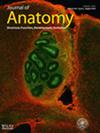对人的身高是否基于足部高度、胫骨长度、股骨长度和上半身长度之间的卢卡斯序列关系进行了评论?还有另一种分析。
IF 1.8
3区 医学
Q2 ANATOMY & MORPHOLOGY
引用次数: 0
摘要
我们饶有兴趣地阅读了《解剖学杂志》上发表的一篇论文[244(5),2024,861-872],题为《人类身高是否基于足高、胫骨长度、股骨长度和上半身长度之间的卢卡斯序列关系?》由Paley等人。作者表明足高、胫骨长度、股骨长度和上半身长度遵循广义的Lucas序列。我们的信表明,他们的结果确实更强,因为他们的数据遵循原始的,齐次的卢卡斯序列。本文章由计算机程序翻译,如有差异,请以英文原文为准。

Some comments on the paper is human height based on a Lucas sequence relationship between the foot height, tibial length, femur length and upper body length? And an alternative analysis
We have read with great interest the paper published by the Journal of Anatomy [244(5), 2024, 861-872] on Is human height based on a Lucas sequence relationship between the foot height, tibial length, femur length and upper body length? by Paley et al. The authors show that foot height, tibial length, femur length and upper body length follow a generalized Lucas sequence. Our letter demonstrates that their result is indeed stronger, as their data follow the original, homogeneous Lucas sequence.
求助全文
通过发布文献求助,成功后即可免费获取论文全文。
去求助
来源期刊

Journal of Anatomy
医学-解剖学与形态学
CiteScore
4.80
自引率
8.30%
发文量
183
审稿时长
4-8 weeks
期刊介绍:
Journal of Anatomy is an international peer-reviewed journal sponsored by the Anatomical Society. The journal publishes original papers, invited review articles and book reviews. Its main focus is to understand anatomy through an analysis of structure, function, development and evolution. Priority will be given to studies of that clearly articulate their relevance to the anatomical community. Focal areas include: experimental studies, contributions based on molecular and cell biology and on the application of modern imaging techniques and papers with novel methods or synthetic perspective on an anatomical system.
Studies that are essentially descriptive anatomy are appropriate only if they communicate clearly a broader functional or evolutionary significance. You must clearly state the broader implications of your work in the abstract.
We particularly welcome submissions in the following areas:
Cell biology and tissue architecture
Comparative functional morphology
Developmental biology
Evolutionary developmental biology
Evolutionary morphology
Functional human anatomy
Integrative vertebrate paleontology
Methodological innovations in anatomical research
Musculoskeletal system
Neuroanatomy and neurodegeneration
Significant advances in anatomical education.
 求助内容:
求助内容: 应助结果提醒方式:
应助结果提醒方式:


